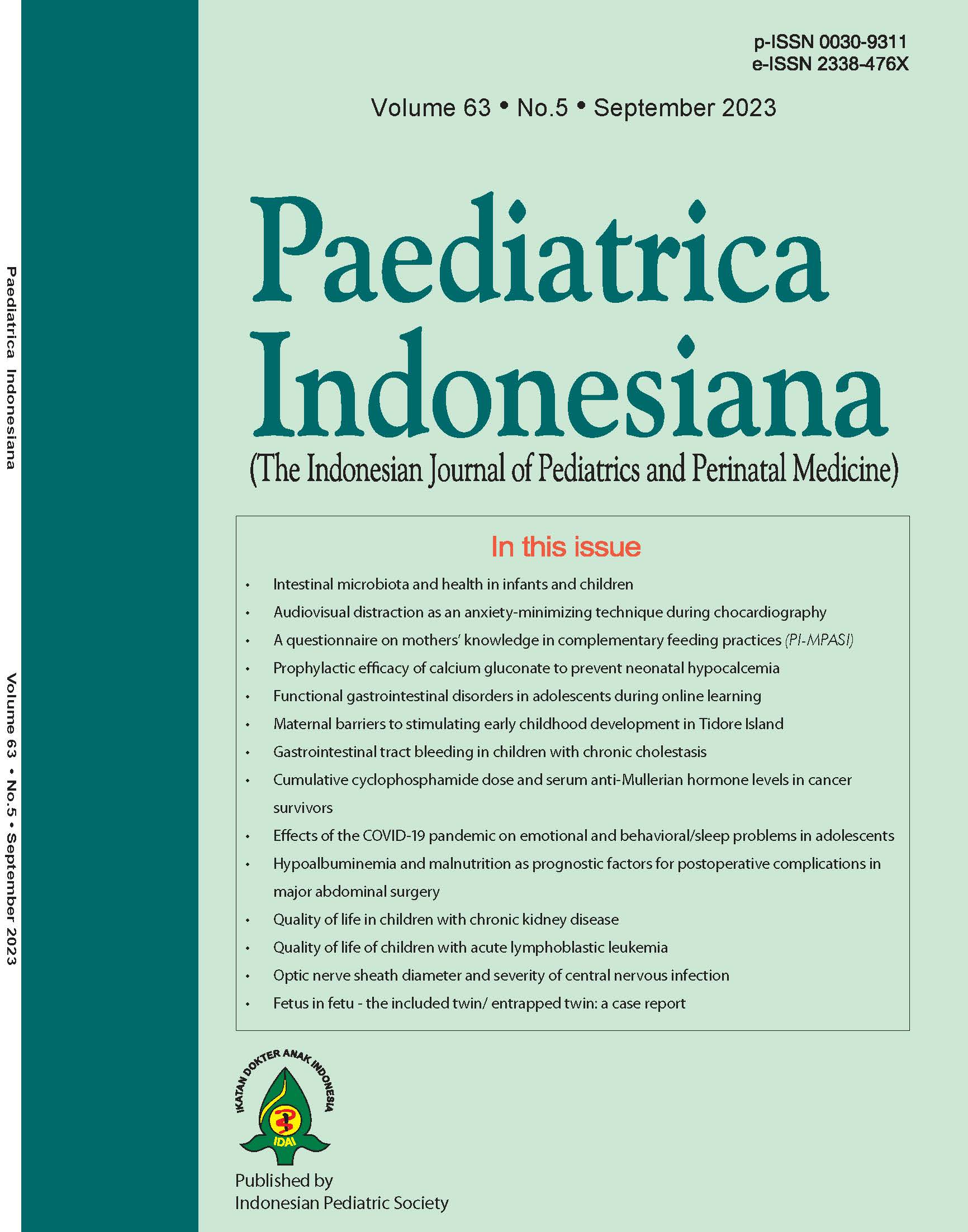Prophylactic efficacy of 400 vs. 200 mg/kg /day calcium gluconate to prevent neonatal hypocalcemia
Abstract
Background Serum calcium is at its lowest level within 24–48 hours after birth, rendering the neonate vulnerable to hypocalcemia. In our center, despite prophylactic administration of 200 mg/kg/day calcium gluconate, the prevalence of neonatal hypocalcemia remains high.
Aim To determine the prophylactic efficacy of 400 vs. 200 mg/kg/day calcium gluconate in preventing neonatal hypocalcemia.
Methods A randomized clinical trial with a pre- and post-test experimental design was done on neonates who fasted or received only minimal enteral feeding. Subjects were randomized to receive either 400 mg/kg/day (intervention group) or 200 mg/kg/day (control group) of intravenous calcium gluconate. We compared serum ionized calcium levels on the first day of admission before calcium gluconate administration and on the third day of hospitalization between the intervention and control groups.
Results The median ionized calcium levels in the intervention vs. control group before calcium gluconate administration was 1.16 (range 0.4-2.4) mmol/L vs. 1.15 (range 0.6-4.5) mmol/L , respectively (P=0.561). After three days of calcium gluconate administration, the median ionized calcium level was 1.19 (range 0.7-1.45) mmol/L vs. 1.19 (range 0.68-4.6) mmol/L in the intervention vs. control group, respectively (P=0.828). The difference in pre- vs. post-administration ionized calcium levels was significant within the intervention group (P=0.032), but not within the control group (P=0.128).
Conclusion Prophylactic intravenous calcium gluconate at 400 mg/kg/day was not more effective in preventing neonatal hypocalcemia than 200 mg/kg/day.
References
2. Peacock M. Calcium metabolism in health and disease. Clin J Am Soc Nephrol. 2010:5Suppl1;S23-30. DOI: https://doi.org/10.2215/CJN.05910809.
3. Kovacs CS. Calcium, phosphorus, and bone metabolism in the fetus and newborn. Early Hum Dev. 2015;91:623-8. DOI: https://doi.org/10.1016/j.earlhumdev.2015.08.007.
4. Thomas TC, Smith JM, White PC, Adhikari S. Transient neonatal hypocalcemia: presentation and outcomes. Pediatrics. 2012;129:1461-7. DOI: https://doi.org/10.1542/peds.2011-2659. Epub 2012 May 21. PMID: 22614771
5. Khan MAG, Upadhyay A, Chikanna S, Jaiswal V. Efficacy of prophylactic intravenous calcium administration in first 5 days of life in high risk neonates to prevent early onset neonatal hypocalcaemia: a randomised controlled trial. Arch Dis Child Fetal Neonatal Ed. 2010;95:462-4. DOI: https://doi.org/10.1136/adc.2009.179663.
6. Nugraha S, Salimo H, Hidayah D. Difference of calcium levels in infants with low birth weight. Indonesian J Med. 2020;5:131-6. DOI: https://doi.org/10.26911/theijmed.2020.05.02.0.
7. French S, Subauste J, Geraci S. Calcium abnormalities in hospitalized patients. South Med J. 2012;105:231-7. DOI: https://doi.org/10.1097/SMJ.0b013e31824e1737.
8. Pacheco Compaña FJ, Midón Míguez J, de Toro Santos FJ. Lesions associated with calcium gluconate extravasation: presentation of 5 clinical cases and analysis of cases published. Ann Plast Surg. 2017;79:444-9. DOI: https://doi.org/10.1097/SAP.0000000000001110.
9. Reynolds PM, MacLaren R, Mueller SW, Fish DN, Kiser TH. Management of extravasation injuries: a focused evaluation of noncytotoxic medications. Pharmacotherapy. 2014;34:617-32. DOI: https://doi.org/10.1002/phar.1396.
10. Patnaik S, Lai YK. Just hypercalcaemia or acute ST elevation myocardial infarction? A review of hypercalcaemia-related electrocardiographic changes. BMJ Case Rep. 2015;21:2015. DOI: https://doi.org/10.1136/bcr-2015-211177.
11. Jeong JM, Lee EH, Heo JS, Choi EK, Park KH, Choi BM. Perinatal risk factors for early onset hypocalcemia in moderate-to-late preterm infants. Perinatology. 2019;30:208-13. DOI: https://doi.org/10.14734/PN.2019.30.4.208.
12. Tsang RC, Light IJ, Sutherland JM, Kleinman LI. Possible pathogenetic factors in neonatal hypocalcemia of prematurity. The role of gestation, hyperphosphatemia, hypomagnesemia, urinary calcium loss, and parathormone responsiveness. J Pediatr. 1973;82:423-9. DOI: https://doi.org/10.1016/s0022-3476(73)80115-5.
13. Dewi R, Rohsiswatmo R. Faktor yang Mempengaruhi Angka Kejadian Hipokalsemia di Ruang Rawat Neonatal. J Indon Med Assoc. 2012;62:386-90. DOI: https://doi.org/10.14238/sp16.6.2015.421-6.
14. Bošnjak I, Raguz MJ. Frequency of neonatal hypocalcaemia and its correlation with risk factors. Clinics in Mother and Child Health. 2017;14:1000276. DOI: https://doi.org/10.4172/2090-7214.1000276.
15. Bandika VL, Were FN, Simiyu ED, Oyatsi DP. Hypoglycaemia and hypocalcaemia as determinants of admission birth weight criteria for term stable low risk macrosomic neonates. Afr Health Sci. 2014;14:510-6. DOI: https://doi.org/10.4314/ahs.v14i3.3.
16. Tohaga E, Budhi K, Wijayahadi N. Hubungan antara derajat asfiksia dengan beratnya hipokalsemi pada bayi baru lahir. Sari Pediatr. 2016;16:29. DOI: https://doi.org/10.14238/sp16.1.2014.29-34.
17. Katz S. Neonatology: management, procedures, on-call problems, diseases, and drugs. Pediatric Emergency Care. 2011;27:162-3. DOI: https://doi.org/10.1097/PEC.0b013e31820a261e.
18. Oberleithner H, Greger R, Lang F. The effect of respiratory and metabolic acid-base changes on ionized calcium concentration: in vivo and in vitro experiments in man and rat. Eur J Clin Invest. 1982:12;451-5. DOI: https://doi.org/10.1111/j.1365-2362.1982.tb02223.x.
19. Khan M, Malik KA, Bai R. Hypocalcemia in jaundiced neonates receiving phototherapy. Pak J Med Sci. 2016;32:1449-52. DOI: https://doi.org/10.12669/pjms.326.10849.
20. Levy-Shraga Y, Dallalzadeh K, Stern K, Paret G, Pinhas-Hamiel O. The many etiologies of neonatal hypocalcemic seizures. Pediatr Emerg Care. 2015;31:197-201. DOI: https://doi.org/10.1097/PEC.0000000000000380.
Copyright (c) 2023 Liza Apsera

This work is licensed under a Creative Commons Attribution-NonCommercial-ShareAlike 4.0 International License.
Authors who publish with this journal agree to the following terms:
Authors retain copyright and grant the journal right of first publication with the work simultaneously licensed under a Creative Commons Attribution License that allows others to share the work with an acknowledgement of the work's authorship and initial publication in this journal.
Authors are able to enter into separate, additional contractual arrangements for the non-exclusive distribution of the journal's published version of the work (e.g., post it to an institutional repository or publish it in a book), with an acknowledgement of its initial publication in this journal.
Accepted 2023-11-01
Published 2023-11-01













